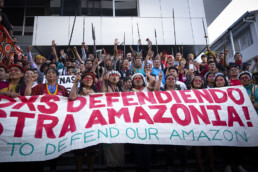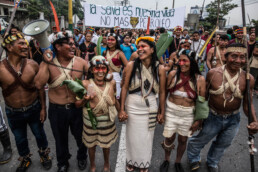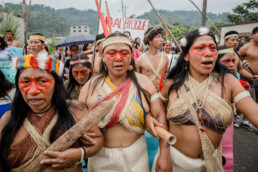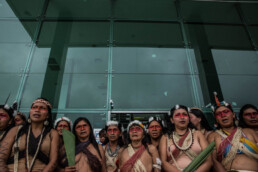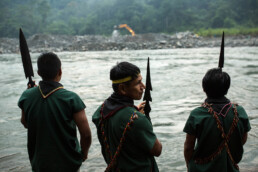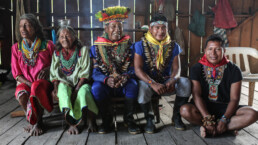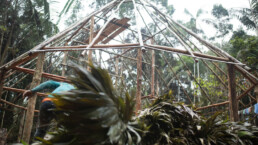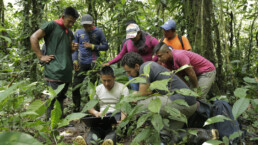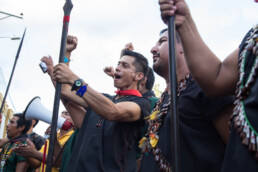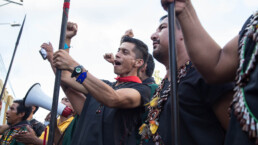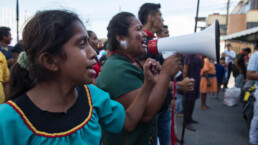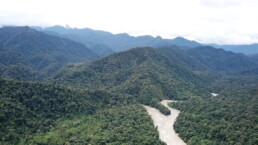Indigenous Nations Unite To Defend Waorani Victory
In the wake of the Waorani people’s recent historic victory, which protects half a million acres of their rainforest territory in Ecuador’s Amazon from oil drilling and sets a key legal precedent for indigenous rights, the government declared that it would appeal the court’s decision. This move poses an imminent threat to indigenous autonomy and the conservation of the Amazon rainforest, the lungs of our planet.
Last week, in Ecuador’s capital city of Quito, the Waorani people spearheaded a mass mobilization, during which hundreds of indigenous peoples from nations including the Kichwa, Sapara, Andoa, Shiwiar, Achuar and Shuar, came together to protect the Waorani victory and to send a clear message to the government: respect indigenous rights.
Recent statements from the Ministry of Energy and Non-Renewable Resources aimed at pressuring the judiciary to overturn the ruling. “The Ecuadorian government has no right to decide over what happens in our territory. We are the ones who make the decisions over lands and lives. The government has every right to appeal and we are not afraid – whether we win or lose this legal case, we will continue to fight because our forest is our life”, affirmed Oswando Nenquimo, a young Waorani spokesperson and plaintiff for the case.
“We have defended our forest for thousands of years, and today we continue to fight”, declared Nemonte Nenquimo, Waorani leader and lead plaintiff outside the head offices of the Ministry of Energy and Non-Renewable Resources in Quito. “The government must listen to our voices and must respect our rights. Our territory is not for sale: this is our decision. How can the government put our lives at risk all in the name of the last drops of crude oil? I’m calling on everyone to stand with us and to unite with our movement: this struggle isn’t just of the Waorani people – it’s for everyone, it’s for our planet.”
Now is a critical time to ramp up support for the Waorani’s urgent struggle to protect the Amazon, and your voice counts. Share your favorite photograph and send a message to the the Ecuadorian government demanding respect for the court’s decision, and to show the judicial system that the world is watching. Together, we can defend indigenous rights in the Amazon!



















The Waorani Resistance in Photos
For elders living in Waorani territory of Ecuador’s Pastaza Province, a ½ million acre roadless wilderness still untouched by the perils of oil, mining and logging, the forest contains nearly everything that is needed for a happy and healthy life.
▼ Here, Pava Yeti, an elder from the village of Kiwaro, makes a basket from palm leaves for harvesting and carrying wild fruits, such as petomo (ungurahua) and nontoka (peach palm).
The Waorani people’s knowledge of their tropical rainforest homeland is legendary. In this photograph, Memo Ahua, from the village of Akaro, uses the Winang plant to imitate the shrill whistling sound of a crying-baby-toucan. Tucked under his shoulder is a 3-meter blowgun made from the chonta palm, a black hardwood, wrapped in a fine leathery bark and sealed with beeswax.
Woven together by hundreds of miles of trails that connect birthplaces with burial grounds, gardens with villages, hunting camps with fishing holes, plant medicines with sacred sites, and backwoods creeks with big water rivers, Waorani elders know every nook and cranny of their immense rainforest home.
In the Oil Fields of the Amazon
Further to the east however, decades of oil extraction have converted thousands of acres of ancestral hunting grounds, fruit orchards and sacred sites into a patchwork of oil fields, logging camps, roads, and colonist settlements.
► In this picture, on the edge of Yasuni National Park famous for its rich biodiversity, a family of Waorani from the Via Pindo oil road walk back to their village along pipelines to avoid the hazards of speeding oil-company 18-wheelers.
And further to the north, in the borderlands with Colombia and Peru, more than a half-century of oil operations and colonization has devastated the ancestral lands of the Kofan, Siona and Secoya peoples.
▼ Here, Emergildo Criollo, a Kofan leader, recalls the first time he saw the oil company helicopter arriving in his people’s ancestral land. “Since then, the oil company has brought nothing but sickness and death to our people,” he tells Nemonte Nenquimo, leader of the Waorani people of Pastaza.
In 2012, the Ecuadorian Government announced plans to auction over 7 million acres of indigenous lands in the southcentral amazon to the oil industry.
Included in the oil auction was the newly denominated “Oil Block 22”, a half million acres of primary rainforest that the Waorani have called home for centuries.
Despite a slick government sponsored campaign to promote investment, many oil blocks, including Block 22, were not successfully sold at auction. Oil investors cited “risks” associated with community opposition and unattractive financial terms.
However, for the Waorani the “failed” oil auction was a warning. And a call to organize.
▼ In this photograph, youth leader Oswando Nenquimo reads a message to the Ecuadorian Government:
“We do not recognize what the government calls Oil Block 22. Our forest homeland is not an oil block. It is our life.”
As a strategy of resistance, from 2015-2018, Waorani youth and elders set out to document and demonstrate life in their territory by creating a “living map” of their connection to the land, using GPS, film, camera traps, drones, and a customized mapping program that allowed them to work offline in remote forest.
Whereas the maps of oil companies only show petroleum deposits and major rivers, the maps that the Waorani created tell the story of their people’s relationship with the plants, the trees, the water, and the animals.
▼ Their maps identify historic battle sites, ancient cave-carvings, jaguar trails, medicinal plants, animal reproductive zones, important fishing holes, creek-crossings, and sacred waterfalls.
▼ In this photograph, school kids in the village of Nemonpare display their drawings of what they like most about life in the forest.
In 2018, the Ecuadorian Government announced renewed plans to auction million of acres of the southcentral Amazon to the oil industry.
In a series of urgent region-wide assemblies the Waorani decided to take legal action to halt the sale of their lands.
▼ In a public hearing in the village of Nemonpare, the Ecuadorian Human Rights Ombudsman takes testimony from youth and elders in preparation for the lawsuit.
Dozens of hours of interviews revealed that the government’s “consultation process” relied on time-tested tactics of manipulation and deceit, and was designed to keep Waorani villagers in the dark about the potential impacts of oil operations in their territories.
“The government came to our village for an hour and promised us hospitals and schools. We didn’t know that they were planning on selling our land to the oil companies.”
− Wina Boyotai from Kiwaro ►
“For the government, the sale of our land was a foregone conclusion. They had already drawn up the plans and the maps. They didn’t come to consult us. They came to trick our people into signing a piece of paper. But we know we have rights, and we are ready to defend them.”
− Oswando Nenquimo from Nemonpare ►
Victory for the Waorani
On February 27, 2019, hundreds of Waorani villagers from “Oil Block 22” marched to the courthouse in the Amazonian frontier town of Puyo to file their landmark lawsuit against the Ecuadorian government. ►
▲ In the courthouse building, the lead plaintiffs wait to file their landmark lawsuit. From left to right, Memo, Omanka, Nemonte, Wina, and Dika.
THE VERDICT IS IN! VICTORY FOR THE WAORANI PEOPLE!
Back to the Forest
After the historic court ruling which protects a half-million acres of their ancestral land from oil drilling, the Waorani returned to their forest homes.
And walked freely in their forest.

The Waorani’s landmark legal victory protects their ancestral homeland from oil and sets a powerful precedent for other indigenous nations to do the same, but this watershed moment could be snatched away in the next two months by a legal appeal. The Ecuadorian judicial system is not immune to political influence, especially with millions of acres of “untapped oil reserves” at stake and the Government’s keen interest in undoing this powerful legal precedent for indigenous rights.
We must seize the momentum, and turn national and global attention into an even bigger victory for indigenous peoples, the Amazon and our climate.
Here’s what you can do today:
For elders living in Waorani territory of Ecuador’s Pastaza Province, a ½ million acre roadless wilderness still untouched by the perils of oil, mining and logging, the forest contains nearly everything that is needed for a happy and healthy life.
▼ Here, Pava Yeti, an elder from the village of Kiwaro, makes a basket from palm leaves for harvesting and carrying wild fruits, such as petomo (ungurahua) and nontoka (peach palm).
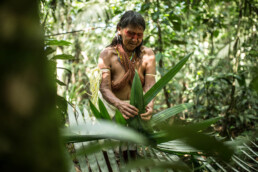
The Waorani people’s knowledge of their tropical rainforest homeland is legendary. ▼ In this photograph, Memo Ahua, from the village of Akaro, uses the Winang plant to imitate the shrill whistling sound of a crying-baby-toucan. Tucked under his shoulder is a 3-meter blowgun made from the chonta palm, a black hardwood, wrapped in a fine leathery bark and sealed with beeswax.

Woven together by hundreds of miles of trails that connect birthplaces with burial grounds, gardens with villages, hunting camps with fishing holes, plant medicines with sacred sites, and backwoods creeks with big water rivers, Waorani elders know every nook and cranny of their immense rainforest home.

In the Oil Fields of the Amazon
Further to the east however, decades of oil extraction have converted thousands of acres of ancestral hunting grounds, fruit orchards and sacred sites into a patchwork of oil fields, logging camps, roads, and colonist settlements. ▼ In this picture, on the edge of Yasuni National Park famous for its rich biodiversity, a family of Waorani from the Via Pindo oil road walk back to their village along pipelines to avoid the hazards of speeding oil-company 18-wheelers.

And further to the north, in the borderlands with Colombia and Peru, more than a half-century of oil operations and colonization has devastated the ancestral lands of the Kofan, Siona and Secoya peoples.
▼ Here, Emergildo Criollo, a Kofan leader, recalls the first time he saw the oil company helicopter arriving in his people’s ancestral land. “Since then, the oil company has brought nothing but sickness and death to our people,” he tells Nemonte Nenquimo, leader of the Waorani people of Pastaza.

▼ In these photographs, Waorani youth and elders visit the oil fields of Lago Agrio to learn firsthand from the Kofan, Siona and Secoya about the impacts of the oil industry.
Upon arriving at an oil platform outside the industry town of Shushufindi in Ecuador’s Amazon Waorani women sing to the oil well: “We walk lightly in the footsteps of our ancestors, we will not let you into our land.”

In 2012, the Ecuadorian Government announced plans to auction over 7 million acres of indigenous lands in the southcentral amazon to the oil industry.
Included in the oil auction was the newly denominated “Oil Block 22”, a half million acres of primary rainforest that the Waorani have called home for centuries.

Despite a slick government sponsored campaign to promote investment, many oil blocks, including Block 22, were not successfully sold at auction. Oil investors cited “risks” associated with community opposition and unattractive financial terms.
However, for the Waorani the “failed” oil auction was a warning. And a call to organize.

▼ Here, Omene Iwa, from the community of Tzapino tells how his ancestors defended the land with spears. For Waorani elders, the current threats are too great to confront with spears alone, and so the youth must find new ways to defend their territory against unrelenting global pressures.

▼ In this photograph, youth leader Oswando Nenquimo reads a message to the Ecuadorian Government: “We do not recognize what the government calls Oil Block 22. Our forest homeland is not an oil block. It is our life.”

As a strategy of resistance, from 2015-2018, Waorani youth and elders set out to document and demonstrate life in their territory by creating a “living map” of their connection to the land, using GPS, film, camera traps, drones, and a customized mapping program that allowed them to work offline in remote forest.
Whereas the maps of oil companies only show petroleum deposits and major rivers, the maps that the Waorani created tell the story of their people’s relationship with the plants, the trees, the water, and the animals.
▼ Their maps identify historic battle sites, ancient cave-carvings, jaguar trails, medicinal plants, animal reproductive zones, important fishing holes, creek-crossings, and sacred waterfalls.
▼ In this photograph, school kids in the village of Nemonpare display their drawings of what they like most about life in the forest.

In 2018, the Ecuadorian Government announced renewed plans to auction million of acres of the southcentral Amazon to the oil industry.
▼ Here is a map illustrating the 16 proposed oil concessions, and their overlap with the ancestral territories of 7 indigenous nations.

“Oil Block 22” was once again up for sale to the highest petrol company bidder.
In a series of urgent region-wide assemblies the Waorani decided to take legal action to halt the sale of their lands.

▼ In a public hearing in the village of Nemonpare, the Ecuadorian Human Rights Ombudsman takes testimony from youth and elders in preparation for the lawsuit.

Dozens of hours of interviews revealed that the government’s “consultation process” relied on time-tested tactics of manipulation and deceit, and was designed to keep Waorani villagers in the dark about the potential impacts of oil operations in their territories.
“The government came to our village for an hour and promised us hospitals and schools. We didn’t know that they were planning on selling our land to the oil companies.” − Wina Boyotai from Kiwaro ▼

“For the government, the sale of our land was a foregone conclusion. They had already drawn up the plans and the maps. They didn’t come to consult us. They came to trick our people into signing a piece of paper. But we know we have rights, and we are ready to defend them.” − Oswando Nenquimo from Nemonpare ▼

▼ Here, in the community of Nemonpare along the Curaray river, villagers prepare banners to take to the city to defend their rights and make their voices heard.
Victory for the Waorani
▼ On February 27, 2019, hundreds of Waorani villagers from “Oil Block 22” marched to the courthouse in the Amazonian frontier town of Puyo to file their landmark lawsuit against the Ecuadorian government.

▼ In these photographs, Waorani women lead the march to the courthouse.
Many indigenous peoples from across the Amazon traveled to support the Waorani peoples’ historic fight to protect their lands from oil drilling. ▼
▼ In this picture, Nemonte Nenquimo, President of the Waorani Organization of Pastaza, carries the lawsuit in her hands, as Amazon Frontlines lawyer, Maria Espinosa addresses a crowd of supporters.

▼ In the courthouse building, the lead plaintiffs wait to file their landmark lawsuit. From left to right, Memo, Omanka, Nemonte, Wina, and Dika.

▼ In these photographs, the Waorani enter the courtroom to face off with the Ministry of Hydrocarbons, the Ministry of Non-Renewable Resources, and the Ministry of the Environment. Photography was not permitted during the court proceedings.
▼ On April 26th, just hours before the landmark verdict in the Waorani trial was announced, Nemonte Nenquimo addresses a crowd of supporters and media on the front steps of the courthouse. “No matter what the court says today we will not let oil in our lands. Our land is not for sale!”

THE VERDICT IS IN! VICTORY FOR THE WAORANI PEOPLE!

▼ Here Nemonte Nenquimo shares details of the historic verdict at a press conference outside the courthouse. The three-judge panel ruled that the Ecuadorian government had violated the Waorani’s rights to prior consultation and self-determination.

▼ In these photographs, the Waorani joyously march through the streets of the Amazonian town of Puyo during a torrential downpour. The court’s ruling immediately halts the government’s plans to sell their land to the oil industry, and sets a precedent for other indigenous nations to do the same.
Back to the Forest
After the historic court ruling which protects a half-million acres of their ancestral land from oil drilling, the Waorani returned to their forest homes.

And drank from the freshwater creeks.

And enjoyed the beauty of the waterfalls.
And walked freely in their forest.


The Waorani’s landmark legal victory protects their ancestral homeland from oil and sets a powerful precedent for other indigenous nations to do the same, but this watershed moment could be snatched away in the next two months by a legal appeal. The Ecuadorian judicial system is not immune to political influence, especially with millions of acres of “untapped oil reserves” at stake and the Government’s keen interest in undoing this powerful legal precedent for indigenous rights.
We must seize the momentum, and turn national and global attention into an even bigger victory for indigenous peoples, the Amazon and our climate.
Here’s what you can do today:
Waorani People Win Landmark Legal Victory Against Ecuadorian Government
Puyo, Ecuador, April 26, 2019 – Today, the Waorani people of Pastaza won a historic ruling in Ecuadorian court protecting half a million acres of their territory in the Amazon rainforest from being earmarked for oil drilling. The decision by the three-judge panel of the Pastaza Provincial Court immediately voids the consultation process with the Waorani undertaken by the Ecuadorian government in 2012, indefinitely suspending the auctioning of their lands to oil companies. The verdict also disrupts the contemplated auctioning of 16 oil blocks that cover over 7 million acres of indigenous territory by providing an invaluable legal precedent for other indigenous nations across the Ecuadorian Amazon.
“The government tried to sell our lands to the oil companies without our permission. Our rainforest is our life. We decide what happens in our lands. We will never sell our rainforest to the oil companies”, said Nemonte Nenquimo, President of the Waorani Pastaza Organization (CONCONAWEP) and plaintiff in the lawsuit. She added, “Today, the courts recognized that the Waorani people, and all indigenous peoples have rights over our territories that must be respected. The government’s interests in oil is not more valuable than our rights, our forests, our lives.”
The court’s decision represents a major setback for the Ecuadorian Government’s plans to develop oil resources across the southcentral Amazon, and could mark a watershed moment in the indigenous movement to permanently protect their rainforest from oil drilling, and other extractive projects. The panel of judges ruled that the Ecuadorian government must repeat the free, prior and informed consent process according to the standards of international law and the Constitutional Court of Ecuador, and that the Ministry of Energy and Nonrenewable Resources and the Ministry of the Environment must sufficiently train government officials regarding the right to free, prior and informed consent and self-determination before sending them out into the field.
“Today we have protected our forest from oil drilling; we have protected our water from contamination; we have protected our children from sickness. This is a legal precedent for indigenous rights”, said Oswando Nenquimo, spokesperson for the Waorani of Pastaza. He added, “But the fight is far from over. The government will appeal because they still want the oil beneath our land. Indigenous Nations across the Amazon and the world must band together to protect our homes.”
The Waorani people’s lawsuit has emerged as flashpoint in the South American country, highlighting the stark gap between the Ecuadorian government’s thirst for oil revenues to relieve international debt and indigenous peoples’ internationally recognized rights to free, prior and informed consent, self-determination, collective territory and the rights of nature. Amidst the backdrop of decades of contamination and cultural disruption in indigenous territories across the Amazon by oil operations, the Waorani’s court victory stands as a landmark victory for indigenous nations fighting to protect the last bastions of wild-standing forest.
In the verdict, the three-judge panel cited a pattern of structural flaws in the 2012 consultation process. These included wide-ranging failings with its design and implementation, including bad faith and false reporting on compliance, unintelligible communications, grossly insufficient time allocation, unaddressed complexities of translation, and poorly crafted informatic materials. But importantly, the ruling also exposed deeper underlying failings, declaring that the government disregarded the Waorani’s traditional governance and decision-making practices, omitted the inclusion of the Waorani’s legitimate traditional elder leaders pikenani in any significant way, broadly failed to guarantee that the Waorani fully understood the implications of the government’s plans for oil drilling in their territory, and did not ensure that they were given the opportunity to make a collective decision regarding those plans.
“This is a major precedent for indigenous rights across the Amazon. Today, the court has recognized a pattern of deceit, bad-faith and manipulative tactics in the Ecuadorian Government’s attempt to earmark the Waorani people’s lands for oil extraction” said Mitch Anderson, Executive Director of Amazon Frontlines. “This is a huge step forward in the battle to ensure indigenous people’s rights over their lands are respected. Guaranteeing indigenous peoples’ rights to decide over their future and to say ‘No’ to destructive extractive projects is key to protecting the Amazon rainforest and halting climate change.”
“The Court’s ruling today declaring the violation of the Waorani’s rights to free, prior and informed consent and self-determination means that the Waorani territory overlapped by Oil Block 22 cannot be sold at auction until those rights are guaranteed. But it should also be interpreted to mean that the State cannot auction off the territories of the six other indigenous nations in the southern Ecuadorian Amazon, which were subject to the government’s same flawed and unconstitutional prior consultation process in 2012. The advance of oil destruction in the southern Amazon was brought to a halt today in this court by the courage and dignity of the Waorani of Pastaza”, said Maria Espinosa, lawyer for the Waorani from Amazon Frontlines.
Hundreds of Waorani youth and elders traveled from their jungle communities and marched through the city of Puyo in celebration, joined by other indigenous nations from across the country, highlighting the widespread support and attention this case has drawn. The Waorani’s global digital campaign to warn the Ecuadorian government that “Waorani territory is not for sale” has built a global movement of solidarity with the struggle, garnering more than 110,000 signatures, and in recent days more than 30,000 people sent emails to the President of Ecuador, his ministers and the court demanding that Waorani rights be respected. More than 50 environmental and human rights organizations published an open letter calling on the judiciary to adhere to well-established national and international law in the Waorani case.
The Ecuadorian state will likely appeal the ruling to the Provincial Court, whose subsequent ruling would be final. The Waorani have pledged to ensure the ruling is upheld in domestic and, if necessary, international courts.
“Now is the time to put even more pressure on the appeals court to ratify this ruling and for the government to respect our right to free, prior and informed consent and self-determination. Tonight, we celebrate, but tomorrow we go back to work to ensure that our territories are oil-free forever,” added Oswando Nenquimo.
The Waorani’s lawsuit is co-filed by CONCONAWEP (Coordinating Council of the Waorani Nationality of Ecuador-Pastaza) and Ecuador’s Human Rights Ombudsmen.
For more information, interviews, or photo/video requests, please contact: Sophie Pinchetti, Communications Coordinator sophie@amazonfrontlines.org
NEWS UPDATE: The Ecuadorian Government has announced that they will appeal the court’s decision. The Waorani are standing firm in their struggle to defend their lands and lives, and they are calling upon the world to help sign this letter to Ecuador’s government to demand respect for Indigenous Rights and the court’s ruling.
Be a Champion for the Amazon!
Start a fundraising campaign to drive resources to Indigenous Earth Defenders on the frontlines
Keep The Oil In The Ground: Waorani Take Ecuador’s Government To Court This Thursday
One of the most biodiverse places on earth – in the heart of the Ecuadorian Amazon rainforest – is under imminent threat from oil drilling. This is the home of the indigenous Waorani people of the Pastaza province, who have protected their ancestral forest lands for thousands of years – and now, they’re ramping up the struggle. On April 11th in the city of Puyo, Ecuador, the Waorani people will be taking the Ecuadorian government to trial alleging numerous human rights violations in the government’s efforts to earmark their lands for oil extraction.
This is a critical moment to build global awareness about the Waorani’s fight to protect their territory, strengthen indigenous land rights, and halt global climate change. Please watch and share this video to support the Waorani in their struggle, and to show the Ecuadorian government and court system that the world is watching to ensure the integrity of the judicial process!
The Waorani people’s efforts to protect their ancestral territory from oil extraction – nearly 500,000 acres of highly biodiverse, primary rainforest – has emerged as a flashpoint in the South American country, highlighting the stark gap between the Ecuadorian government’s thirst for oil revenues to relieve international debt and indigenous peoples’ internationally recognized rights to free, prior and informed consent, self-determination, collective territory and the rights of nature.
This Thursday, the Waorani will be mobilizing in the city of Puyo, bringing hundreds of leaders, warriors, fisherman, medicine people, elders and youth from deep in their forest territory to the courthouse. Donate now to help fund their logistics (transport, lodging, food). Every dollar will go directly to on-the-ground organizing costs.
Amidst the backdrop of decades of contamination and cultural disruption in indigenous territories across the Amazon by oil operations, the Waorani’s lawsuit aims to protect their homeland, one of the last bastions of wild-standing forest, from a similar fate. Alongside their legal action, the Waorani are using high-tech maps, global campaign strategies and multi-nation organizing to spearhead a resistance movement opposing fossil fuel extraction and to galvanize the protection of nearly 7 million acres of indigenous territory – a critical stronghold in the battle against climate change.
Amazon Frontlines will be standing with our indigenous Waorani partners on the ground as they take on the Ecuadorian government to demand respect for their rights, and to protect a forest which gives life to us all. Please stand in solidarity by reading and signing the Waorani’s petition, which they will be handing into the government in the coming months.

“Without Unity, There Can Be No Triumph”: An Indigenous Voice on a Historic Victory Against Gold Mining In The Amazon
On this Day of International Human Rights, Alex Lucitante, a young indigenous leader from the Kofan people, shares his experiences from the frontlines of a historic victory against gold mining in ancestral Kofan territory. From reviving ancient yagé ceremonies (also known as ayahuasca) to strengthen community resistance to using technology in the defense of their land, the small community of Sinangoe’s path to victory and their struggle ahead is one marked by a fusion of innovation and ancestry – and above all, unified determination to protect their rainforest home from extractivism.

When Sinangoe’s victory happened on October 22nd 2018, I cried and felt so much emotion. It took a lot of sacrifice to get to that victory, which nullified 52 mining concessions on our ancestral territory that had been granted by the government in violation of our right to consent.
The community’s dream was what sparked this fight. Our territory gives us everything we need: it is our pharmacy, our supermarket. There lies our history, our roots, and the life that enables us to live in harmony. That is why it is so important for us to protect it, it is our home.
Mining threatened our territory. It threatened the river and the spiritual places which give us life and which teach us respect for life. For the Kofan people, the river is not just water and stones. To see a fish is to see food, and to see water is to see life in the river. If the rivers are contaminated, what will happen? In the spiritual world, when the spirits of the jungle leave us, everything else we have also gets lost. The community will no longer bother taking care of the river, because it won’t make sense. They will start working and buying things that are not from the territory, they will begin to dream with money and they will begin to destroy the territory.
“Mining threatened our territory, our rivers and the spiritual places which give us life”
Our ancestors taught us to fight with truth and respect. That helped us so much on this path. Beyond our spears, our crafts, our way of life, our language – yagé, or ayahuasca, is a deep part of our identity as Kofan. Sinangoe still does not appropriate what is proper to us. We were divided by the Evangelism or “civilization” which the Kukamas [outsiders] imposed upon us. They convinced our people that drinking yagé was diabolical. Our wisest elders were deceived and finally stopped drinking yagé.
So the youth of Sinangoe grew up without the knowledge of yagé – until this struggle began. With the community guard, we went to my father’s territory to drink yagé. We went to Siona territory, where some of the people have maintained the practice despite evangelization, and there we also drank yagé. From then onwards, some young people learned to prepare it and they now are drinking with the elders, ancestral wisdom-keepers. Then began the construction of the ceremonial house in Sinangoe earlier this year, when the community began the struggle in defense of its territory. First the struggle emerged and then the cultural recovery – and now all of this continues.
“Drinking yagé allowed for respect to grow amongst everyone, it strengthened our unity”
The main vehicle for this struggle was the unity of the community. That unity was built through hard work and difficult times because Sinangoe was previously divided by political issues, the personal interests of certain groups, and different ways of thinking. But it was not entirely divided: there was still this dream to remain united, to do something for the community and for the territory.
Drinking yagé made respect grow amongst everyone, it strengthened the unity. It made people understand that what is our is ours, and no one can take that away from us. Yagé helps you to understand your life but it is also makes you understand the life of the forest – when you hear its chants, its sounds, that is where there is life. You see mountains and you see that this is sacred land. It is where the spirit of the jaguar rests and wanders, and where the sound of the wind fuses to the forest, and this creates harmony so that everything can be well. We are not greater than the forest or our territories, we are equal, we are the same: this is the Kofan vision. And so through yagé, we become stronger on this path.
If we ask ourselves why Kofan territories or indigenous territories have been kept intact until today, and why they contain more land and biodiversity than anywhere else, it is because our ancestors cared for and defended our territories. The current community guard of Sinangoe is nothing new – it is something that has been a fact since the existence of the Kofan people; our ancestors were these guards.

But during this process of struggle, in exercise of our right to autonomy and self-governance, we saw the need to formalize this guard on paper and create a law prohibiting activities that certain groups, companies or people were doing in disrespect of the community. The community’s voice was not being heard and the State was not guaranteeing our rights. For example, there were people putting shotgun traps to hunt animals in order to sell them, throwing dynamite, poison and all kinds of chemical substances into the rivers, dredging the territory and destroying mountains… So our ancestors’ mandate applied, to defend our ancestral territory through the means of a guard, by means of our warriors.
“The State must guarantee our rights to our territories”
Technology, paired with the guard’s ancestral knowledge of our territory and how to navigate the river and adapt ourselves in the jungle, was very important in the Sinangoe case. The camera traps and drones served to document and monitor what was happening in the territory. At first, there were threats towards our leaders – “if we see you Kofan here, we will take out our machetes, we will cut off your head” – that is how the miners threatened us. But with all the photographic evidence which Sinangoe collected through camera traps and drones, we were able to file a demand for an action of protection. The denouncement was made public before the authorities, and through the media we alerted the world about the changes that were happening in our territory, about the illegal invasions but also about the mining concessions granted by the Ecuadorian government without our consent. When this happened, investigations were opened, and from then those who threatened us remained silent.

A few weeks ago, we met with the United Nations Special Rapporteur on Indigenous Rights during her visit to Ecuador. We explained how the State was not recognizing our rights to our territories as Kofan people, the State was violating our rights. We need the State to guarantee our rights through land titling. We also demanded that the State recognize the role of indigenous guards as guardians of ancestral territories and for the protection of the rainforest and biodiversity, because to this day, the State has been incapable of doing so. Instead, the State has accused us of being “paramilitaries”, “militia groups”, “accomplices of the miners”. But the Rapporteur met the guard to understand its structure and how it protects our territories: with respect, strength, and love in the heart.
Now the community is beginning a process to map out its territory, they will be walking long distances to gather evidence of sites of great importance in order to demand that the State recognize their territory through a property title. The State wants to have authority over these territories but they must respect our ancestry. With the case’s sentence and all the support and alliances that Sinangoe now has, we are confident that we will be able to secure this land title. And when we secure this land title, we will be stronger in our fight to guarantee our cultural and physical survival.
The struggle of Sinangoe doesn’t just represent the Ecuadorian Amazon. It also speaks to other countries – where indigenous peoples want to fight and confront these big issues but still feel lost because they do not really understand who they are as a people. In reality, we, indigenous peoples are subject to rights just like nature, so we must fight and defend who we are. When there is consciousness, as there is in the case of Sinangoe, people view who they are with pride and love. We raise our spears and say we are Kofan, and so what? It does not matter that we do not have the dream of the white man or of the extractivist to own a lot. We have the dream of our ancestors, which is the ancestral right to be who we are and live as we want to live. That is the message from Sinangoe to the world: get up, raise your voice, but always be united. Without unity, there will be no triumph.

List of chronicles in our series on Sinangoe:
Nothing found.
Stopping a gold rush in the Amazon: 7 reasons why the Kofan landmark victory is so huge
Facing the mounting pressures of the global race for gold and other metals across the globe, it’s not everyday that a small indigenous community wins a lawsuit against the government that nullifies over 50 mining concessions threatening their health and land, and grants full restoration of the damages done. Last week’s landmark victory for the Kofan people of Sinangoe, at the headwaters of the Aguarico River in the Ecuadorian Amazon, is testament to the importance of indigenous-led resistance against extractivism in the world’s largest tropical rainforest.
This community’s path to victory involved a myriad of strategies ranging from environmental monitoring to innovative legal actions and alliance-building with civil society, provincial governments and international organizations. Its example should provide inspiration and tools to other indigenous peoples facing similar threats to their ancestral lands, cultures and rights. Here are 7 major reasons why Sinangoe’s case is so important.
1. It safeguards the ancestral Kofan way of life
Kofan culture is deeply connected to the land: their entire way of life depends upon the rivers and forest. When the Kofan discovered that their ancestral territory along the Cofanes and upper Aguarico rivers had been granted to mining companies without their permission, they immediately recognized the gravity of this threat to their way of life and autonomy, and to other communities downriver. Damage to these rivers means damage to the Kofan themselves. Their triumphant legal battle, which brought four Ecuadorian State authorities to court, not only denounced the lack of consultation, but also highlighted the violation of their rights to water, food security and a clean environment – fundamental rights imperative to the integrity and survival of Kofan culture.
The Kofan people of Sinangoe have won a landmark legal battle to protect the headwaters of the Aguarico River, strengthening collective rights to Free, Prior and Informed Consent over any extractive activity in indigenous lands.
2. It shows the effectiveness of indigenous-led environmental monitoring
It was Sinangoe’s community land patrol that sounded the alarm when they witnessed the first machines digging up the banks of the Aguarico River in early 2018. This land patrol, trained and formed one year before in partnership with Amazon Frontlines and our indigenous partners Ceibo Alliance, immediately documented and reported the invasion. Over the course of several field trips, the land patrol meticulously built up an extensive archive of images, drone footage and maps, which played a central role in their landmark victory, providing irrefutable evidence of the environmental damages of gold mining on their land to the judges and court. This victory should embolden any community using environmental monitoring techniques, whether it be camera traps, GPS, video recorders, drone, satellite imagery and/or land patrols.
Over the course of 2 years, Sinangoe’s land patrol have used a wide range of strategies and technologies to detect, document and stop gold mining inside and around their ancestral land.
3. It sets a legal precedent for indigenous rights in Ecuador and beyond
The decision by the Provincial Court is without precedent in Ecuador, and takes huge steps towards the protection of indigenous and environmental rights. First, there is the concrete: 20 concessions improperly granted to mining companies canceled; 32 concessions under review for approval indefinitely suspended; and full remediation of damages already caused by the mining activity. But this sentence has deeper repercussions for a country with 14 indigenous nations and some of the world’s most important natural resources. The court’s recognition that the government must consult indigenous communities when the proposed activity affects their territory, even if it doesn’t occur directly on their legally recognized land, is a huge win for indigenous rights to Free, Prior and Informed Consent. Equally important is the recognition of the rights of nature, as well as the use of the precautionary principle, always applicable but seldom-applied in Ecuador, which vests the government with the responsibility to protect the public from harm (in this case to the environment and to the right to water and food security) BEFORE irreversible damage occurs unless scientific evidence can prove otherwise. The court’s decision advances the law in Ecuador, paving the way for other communities to exercise their rights and protect their territories.
4. It protects one of the most biodiverse places on Earth from rampant deforestation
By halting all mining operations along the headwaters of one of Ecuador’s most important rivers, the Kofan have saved 32,000 hectares (79 000 acres) of the most biodiverse rainforest in the country and amongst the most biologically rich places on Earth. The area, fed by the Cofanes and Chingual Rivers, is home to over 3,725 species of plants, 650 species of birds and 50 species of mammals, including various endemic and endangered species like the spectacled bear and the mountain tapir. This biological hotspot’s fragility and uniqueness mean even limited road building and small-scale deforestation could have disastrous impacts on the local flora and fauna. This legal victory affords respite for these wild places and highlights the incompatibility of mining in this pristine Amazon rainforest.
5. It contributes to the fight against the global climate crisis
As deforestation continues to spread across the Amazon, and with the Ecuadorian Amazon having already lost 675,000 hectares of pristine rainforest since 1990, protecting intact refuges like Sinangoe’s ancestral land and its rich surroundings is key to combating climate change. Each hectare of forest in this area contains between 245 to 633 tons of carbon stored in its vegetation and soils, amongst the highest carbon densities in the Amazon1. Avoiding deforestation over 32,000 hectares of this rainforest means avoiding the release of at least 7.8 million tons of carbon to the atmosphere, or the equivalent average yearly carbon emissions of more than 1.7 million cars2.
Deforestation along the banks of the Aguarico River detected by Sinangoe’s land patrol in April 2018.
6. It avoids hazardous contamination of one of the biggest rivers in Ecuador
The Ecuadorian government granting of 52 mining concessions posed a significant threat to the Aguarico river, which crosses the entire Ecuadorian Amazon, providing water to dozens of indigenous communities and to some of the largest cities of the area. Gold mining operations in the Amazon are amongst the main causes of contamination from anthropogenic mercury, a highly toxic heavy metal contaminating water sources and causing serious health impacts for all beings. Moreover, Ecuador allows the use of cyanide for gold extraction, another toxin released into rivers that can pose a serious risk to water quality and health due to its high toxicity. Following Sinangoe’s urgent request during the lawsuit, the Aguarico, Cofanes and Chingual rivers were declared protected water resources by Ecuador’s national water authority (SENAGUA), blocking any mining and any future concessions directly on the banks of these vital rivers, a first in Ecuador.
The Kofan people of Sinangoe have succeeded in building strong ties with allies both nationally and internationally, helping them gain leverage in this fight against the Ecuadorian government.
7. It demonstrates that forging cross-cultural alliances is critical to success
This legal battle would never have been possible if the people of Sinangoe didn’t value their territory, put in long, hard hours patrolling their land, and sustain unity within the community. But that alone wouldn’t have won the battle. What Sinangoe also knew to do was connect with other communities and organizations and reach out for support where needed. Over the course of Sinangoe’s battle against gold mining, over 59 national and international organizations, 14 riparian communities of the Aguarico, the provincial and municipal governments and even the highly influential Catholic Church gave their support to the community, increasing Sinangoe’s leverage and visibility. This example shows that communities in resistance are stronger when they are united, and that cross-cultural alliances work when they are based on mutual respect and trust.
1 Bertzky, M., Ravilious, C., Araujo Navas, A.L., Kapos, V., Carrión, D., Chíu, M., Dickson, B. (2011) Carbono, biodiversidad y servicios ecosistémicos: Explorando los beneficios múltiples. Ecuador. UNEPWCMC, Cambridge, Reino Unido. http://www.unredd.net/index.php?option=com_docman&task=doc_download&gid=6148&Itemid=53
2 EPA. Greenhouse Gas Emissions from a Typical Passenger Vehicle. https://www.epa.gov/greenvehicles/greenhouse-gas-emissions-typical-passenger-vehicle
List of chronicles in our series on Sinangoe:
Nothing found.
An unprecedented legal victory for indigenous rights in Ecuador frees up huge swath of Amazonian rainforest from gold mining
On October 22nd 2018, the Kofan people of Sinangoe in the Ecuadorian Amazon won a landmark legal battle to protect the headwaters of the Aguarico River, one of Ecuador’s largest and most important rivers, and nullify 52 mining concessions that had been granted by the government in violation of the Kofan’s right to consent, freeing up more than 32, 000 hectares of primary rainforest from the devastating environmental and cultural impact of gold mining. This precedent-setting decision will inspire indigenous nations across the Amazon and land defenders worldwide for years to come.
The Kofan people of Sinangoe, with the support of Amazon Frontlines and the Ceibo Alliance, have been successful in forcing the Ecuadorian government to cancel all mining concessions on and around their ancestral land, a groundbreaking victory for indigenous rights in Ecuador.
In a historic ruling, the Provincial Court accepted evidence of environmental impacts provided by the community of Sinangoe and the provincial ombudsman, charged the government with not having consulted the Kofan, denounced the mining operations for having violated indigenous rights to water, food and a healthy environment, and cancelled all mining activity in more than 52 concessions at the foothills of the Andes. The ruling, which cites the precautionary principle and uses Ecuador’s new law on the rights of nature, also forces authorities to set in place restoration measures in an area that had been already heavily impacted by the mining operations.
“This is a great victory for our community, for our people and for all indigenous peoples. We are not just fighting for our people, but for everyone who depends on clean water and clean air. This victory is a huge step forward for our children and for future generations. We will remain vigilant in our territory and will continue fighting until we have legal title over our entire ancestral homeland.”
– Mario Criollo, President of the community of Sinangoe.
After only 4 months of mining operations, the environmental damages we have witnessed and documented for the court case provided a strong set of evidence on how granting mining concessions in such a fragile and rich environment is totally incompatible with the Kofan way of life and the conservation efforts needed in this biodiversity hotspot. The area now freed from mining activity is one of the most biodiverse areas on Earth. It is home not only to the Kofan people who depend on its fresh water for survival, but also to more than 3,725 species of plants, 650 species of birds and 50 species of mammals.
Mining operations threaten profound and irreversible environmental and cultural damage in this ecological hotspot as well as the health of the people of Sinangoe and thousands of people in dozens of indigenous communities downstream. Further exposing this highly diverse primary forest to uncontrolled deforestation would also accelerate the global climate crisis.
The headwaters of the Aguarico River, at the core of the Kofan ancestral land and one of the main artery of the Ecuadorian Amazon, were threatened by mercury and cyanide pollution commonly used in gold mining operations in the Amazon, until the Kofan successfully blocked it by suing the Ecuadorian government.
After months of ongoing land patrols, the use of camera traps, drones and satellite imagery, as well as indigenous-driven media campaigns to raise awareness of destructive mining practices, the Kofan people, with the support from Amazon Frontlines and our indigenous partners from the Ceibo Alliance, have succeeded in demonstrating the importance of indigenous-led environmental monitoring and sustained innovative legal strategies to protect their land and rights. Sinangoe now has the important task of ensuring the ruling is respected and the measures dictated by the Courts are enforced on the ground.
“This is a major win for indigenous rights in Ecuador, and a huge wake up call to the Ecuadorian government. Before viewing the land for the minerals underneath it, the Courts now forces authorities to obtain consent from the indigenous peoples who call it home, and to properly evaluate the environmental and cultural costs of allocating such biodiverse hotspots to gold miners.”
– Maria Espinosa, Amazon Frontlines’ legal coordinator and Sinangoe’s lawyer.
List of chronicles in our series on Sinangoe:
Nothing found.
The Kofan people ramp up the fight to protect one of the most biodiverse forests in the Amazon
In January 2018 the Ecuadorian Government concessioned off over 30,000 hectares of some of the most bio-diverse rainforest in the Amazon to an array of mining interests, precipitating a gold-mining boom in the ancestral lands of the Kofan people. There were no prior meetings. No consultation. No information provided to the Kofan villagers of Sinangoe. No permission was asked. The arrival of big machinery, water pumps and dozens of miners was the only courtesy the government gave the ancestral guardians of this biodiversity hotspot.
After months of ongoing land patrols, the use of camera traps, drones and satellite imagery, as well as innovative legal strategies and indigenous-driven media campaigns to raise awareness about destructive mining practices, the Kofan people are on the verge of winning a landmark legal battle to protect the headwaters of the Aguarico River and contribute to the national movement to strengthen collective rights to Free, Prior and Informed Consent over any extractive activity in indigenous lands.
Over 30 000 hectares of mining concessions were granted by the Ecuadorian government in the headwaters of the Aguarico River, Ecuadorian Amazon, without any Free, prior and informed consent from the Kofan community of Sinangoe.
The Kofan peoples’ ancestral rainforest homeland is a miracle of biodiversity – a headwater region where Amazonian forest ascends steep mountainous cliffs into the Andean foothills, home to more species per hectare than anywhere else in Ecuador. The Kofan people, recently featured in a Foreign Policy story about the advantages of indigenous land stewardship, are achieving international recognition for their conservation efforts – which combine cutting-edge tech, weekly land patrols, and tenacious legal advocacy.
Yesterday, the Kofan people’s efforts received an additional boost with a strongly worded letter to Ecuador’s president, Lenin Moreno, signed by 55 national and international organizations, including Greenpeace, Hivos, Amazon Watch and Rainforest Fund. The support comes after the community won a first legal battle in court against four Ecuadorian ministries back in July 2018. In this ruling, a regional judge recognized that Sinangoe’s right to free, prior and informed consent had been violated, and suspended all mining operations in the Aguarico headwaters.
“The presence of mining in the headwaters of the Aguarico River represents a threat to the health of the people of Sinangoe and thousands of people who live downstream, exposes this highly diverse primary forest to uncontrolled deforestation and accelerates the global climate crisis.” – Letter to Lenin Moreno, President of Ecuador
The decision in the lower courts was immediately appealed by all the authorities, and then by Sinangoe and their ally in the Defensoria del Pueblo, who seek an even tougher verdict recognizing that rights to health, water and a clean environment had also been violated and also that the concessions be revoked, not just suspended. The case will be brought in front of provincial judges tomorrow, September 5th 2018, where hundreds plan to gather at the Court of Appeals in the amazonian town of Lago Agrio, coming in support of the Kofan Nation and in defense of the Aguarico River, its pristine headwaters and the vital water it provides to thousands of amazonian people. Stay tuned for more on Sinangoe’s struggle.
List of chronicles in our series on Sinangoe:
Nothing found.
Historic indigenous legal victory against gold mining in the Amazon
In a lawsuit that will inspire and galvanize many other indigenous communities across the Amazon for years to come, the Kofan of Sinangoe have won a trial against four Ecuadorian ministries and agencies for having granted or attempted to grant more than 30,000 hectares of mining concessions in pristine Amazonian rainforest on the border of their ancestral land without their free, prior and informed consent. The destructive mining operations that were taking place within these concessions threatened not only the Kofan’s lives, culture and health, but also those of the countless communities located downriver.

In a historic decision on Friday July 27th 2018, a regional judge accepted the evidence provided by the community, charged the government with not having consulted the Kofan, and suspended all mining activity in more than 52 concessions in the headwaters of the Aguarico River. The decision was immediately appealed by all the authorities involved, and then by Sinangoe and their ally in the Defensoria del Pueblo, who seek an even tougher verdict recognizing that rights to health, water and a clean environment had also been violated. The case will be brought before a provincial judge in August, 2018.
The free, prior and informed consent loophole
Like in many places around the world, the Ecuadorian government has a mining claim system built to facilitate any interested party in purchasing cheap concessions— maximizing foreign interests and accelerating the approval process. Although both Ecuador’s Mining Act and the Constitution recognize the need for Free, Prior and Informed Consent from stakeholder communities for mining operations, it is still mostly a theoretical concept ignored by Ecuadorian agencies. Hence Sinangoe’s lawsuit. According to the experts heard over the course of the legal process, the Mining ministry leaves the “consultation” to the mining company or the concession owners themselves, which in turn have no legal obligation to consult with local people, and often will perform their “consultation” through a phone call or by handing out a simple information pamphlet. In the case of Sinangoe, it was when machines started tearing up the riverbed of the Aguarico looking for gold that the community learned about the new concessions.
The entire length of the Kofan River, a symbolic water body that crosses Sinangoe’s land, has been sold to gold miners by the Ecuadorian authorities without prior and informed consent. Mining in this area would cause dramatic environmental and cultural damage.
The Environment ministry, on the other end, stipulated in the courtroom that it is not responsible for consulting with communities impacted by mining. Interestingly, according to the Mining Act, the Environment Ministry needs to grant environmental licenses before operations can begin, unless the granting process takes more than 6 months, in which case – as unbelievable as this is – the permits are automatically granted to the operators. So basically, via a very simple bureaucratic process involving nothing more than paperwork, a mining operator can very quickly obtain 20 to 25-year land claims within 6 months, while the impacted communities living downstream haven’t even heard about the concessions. This is a loophole the judge described as a violation of the right to free, prior and informed consent, a verdict that will help many other communities facing the same threats in a country where gold mining is booming.
When rigorous community monitoring pays off
Throughout the lawsuit, the ministries’ lawyers vigorously tried to destroy Sinangoe’s evidence, credibility, ownership of and ancestral claims to the land. They downplayed the environmental damage documented by Sinangoe, claiming that the Kofan aren’t impacted by the mining operations because their land is on the other side of the river and that legal mining has minimal footprint on the environment. However, Sinangoe had done what will likely inspire many other communities: they had documented every step made by the miners through rigorous and systematic monitoring using high tech mapping, filming, archiving all evidence, and then they used legal tactics to pressure every single level of government to act to stop the operations. Systematic recording of all the different types of evidence helped build a solid case against a negligent concession-granting system.
Once in the courtroom, Sinangoe had accrued such a massive body of evidence of environmental damage and inaction on the part of the government that the judge requested a field inspection, a key event that helped him understand the scale of the damage already done, showed the deep connection the Kofan have with the area transformed into mining concessions, discredited the ministries’ arguments, and also allowed him to witness the sheer beauty of the area at risk.

A first legal victory, but the battle for land and rights still rages
To the officials sitting in their offices in Quito, these concessions were nothing more than coordinates and squares on a map, but to the Kofan who live across the riverbank, the area is a place imbued with life, history, sustenance, stories and so much more. To grant concessions without experiencing the place in and of itself, either through field visits or proper consultation with the people who inhabit and use the territory, is a transgression of the inherent value of sites so rich in history and biodiversity.

Sinangoe’s strength has been put to trial, and the community’s perseverance and conviction have provided them a first legal victory and attracted support from various indigenous and human rights organization across the country. With all ministries involved appealing the judgment, the Kofan will need more strength and support to navigate the next wave of legal governmental intimidation.
Sign the pledge in support of Sinangoe and stay tuned for more on our work to defend rights, lands and life in the Amazon.
List of chronicles in our series on Sinangoe:
Nothing found.
